Reception
Thomas Goonan, writing for Library Journal , rated the book "[r]ecommended," praising its "[e]xcellent illustrations" that "elucidate the text" and "[g]ood index. Comparing it to Edward Stoddard's The Story of Power, he judged de Camp's work "[m]ore comprehensive and detailed." [4]
The Science News-Letter, in its September 23, 1961 issue, listed the book among its "Books of the Week," describing the work as a "[c]olorful panorama depicting and describing man's development of sources of energy to help him build, move around and produce." [5]
The Booklist considered the subject "effectively presented in well-written text and a multitude of supplementary [illustrative materials], all captioned and most of them in color. Its review repeated Goonan's judgment of the work as "more comprehensive" than Stoddard's. [3] In appraising the work for older children, The Booklist noted it was "[j]uvenile in approach but may be useful in high schools, particularly for its illustrations. [6]
Isaac Asimov, writing for The Horn Book Magazine , called it "an exciting book written with great authority and illustrated lavishly," noting that "[f]or young people interested in mechanics and machinery this book is a complete feast." He finds that "[t]he human mind is the hero throughout," with "[t]he personalities of scientists interest[ing] Mr. de Camp only as they affect the scientists as conveyors of new thoughts." [7]
Claire Huchet Bishop in The Commonweal praised the book's "[e]xcellent approach which makes less of the machines than it does of the minds that created them." [8]
Henry W. Hubbard in The New York Times wrote that "Mr. de Camp has filled his book with accurate information and absorbing history," but noted that while "[t]he writing is usually good, ... the first chapter, on manpower, suffers from jarring transitions, and the detailed explanations of steam engines and such are occasionally hard to follow." He finds the illustrations "colorful and skillfully chosen. They are, in fact, the high point of the book." Summing up, he states that "[b]y virtue of its thoroughness, and its informative illustrations, "Man and Power" should be especially useful in libraries and schools." [9]

Lyon Sprague de Camp was an American author of science fiction, fantasy and non-fiction literature. In a career spanning 60 years, he wrote over 100 books, including novels and works of non-fiction, including biographies of other fantasy authors. He was a major figure in science fiction in the 1930s and 1940s.

Unknown was an American pulp fantasy fiction magazine, published from 1939 to 1943 by Street & Smith, and edited by John W. Campbell. Unknown was a companion to Street & Smith's science fiction pulp, Astounding Science Fiction, which was also edited by Campbell at the time; many authors and illustrators contributed to both magazines. The leading fantasy magazine in the 1930s was Weird Tales, which focused on shock and horror. Campbell wanted to publish a fantasy magazine with more finesse and humor than Weird Tales, and put his plans into action when Eric Frank Russell sent him the manuscript of his novel Sinister Barrier, about aliens who own the human race. Unknown's first issue appeared in March 1939; in addition to Sinister Barrier, it included H. L. Gold's "Trouble With Water", a humorous fantasy about a New Yorker who meets a water gnome. Gold's story was the first of many in Unknown to combine commonplace reality with the fantastic.
George H. Scithers was an American science fiction fan, author and editor.

John Drury Clark, Ph.D. was an American rocket fuel developer, chemist, and science fiction writer. He was instrumental in the revival of interest in Robert E. Howard's Conan stories and influenced the writing careers of L. Sprague de Camp, Fletcher Pratt, and other authors.
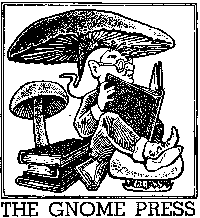
Gnome Press was an American small-press publishing company primarily known for publishing many science fiction classics. Gnome was one of the most eminent of the fan publishers of SF, producing 86 titles in its lifespan — many considered classic works of SF and Fantasy today. Gnome was important in the transitional period between Genre SF as a magazine phenomenon and its arrival in mass-market book publishing, but proved too underfunded to make the leap from fan-based publishing to the professional level. The company existed for just over a decade, ultimately failing due to inability to compete with major publishers who also started to publish science fiction. In its heyday, Gnome published many of the major SF authors, and in some cases, as with Robert E. Howard's Conan series and Isaac Asimov's Foundation series, was responsible for the manner in which their stories were collected into book form.
The Trap Door Spiders are a literary male-only eating, drinking, and arguing society in New York City, with a membership historically composed of notable science fiction personalities. The name is a reference to the reclusive habits of the trapdoor spider, which when it enters its burrow pulls the hatch shut behind it.

The Dragon of the Ishtar Gate is a historical novel by American writer L. Sprague de Camp, first published in hardcover by Doubleday in 1961, and in paperback by Lancer Books in 1968. The first trade paperback edition was issued by The Donning Company in 1982. The book was reissued with a new introduction by Harry Turtledove as a trade paperback and ebook by Phoenix Pick in September 2013. It is the third of de Camp's historical novels in order of writing, and earliest chronologically. It is set in 466-465 BCE, the last years of the reign of King Xerxes I of Persia.

Engines: Man's Use of Power, from the Water Wheel to the Atomic Pile is a science book for children by L. Sprague de Camp, illustrated by Jack Coggins, published by Golden Press as part of its Golden Library of Knowledge Series in 1959. A revised edition was issued in 1961, and a paperback edition in 1969. The book has been translated into Swedish, Norwegian, Finnish, Portuguese, and German.

Darwin and His Great Discovery is a science book for young adults by L. Sprague de Camp and Catherine Crook de Camp, first published by Macmillan in 1972.

The Day of the Dinosaur is a science book by L. Sprague de Camp and Catherine Crook de Camp, illustrated with plates. It was first published in hardcover by Doubleday in 1968, and in paperback by Curtis Books in 1970 or 1971. A second hardcover edition was issued by Bonanza Books in 1985. The first chapter was reprinted as "One Day in the Cretaceous" in the de Camps's collection Footprints on Sand.

The Story of Science in America is a 1967 science book by L. Sprague de Camp and Catherine Crook de Camp, illustrated by Leonard Everett Fisher, published by Charles Scribner's Sons. It has been translated into Spanish, Portuguese, Burmese and French.

Footprints on Sand: a Literary Sampler is a 1981 collection of writings by science fiction authors L. Sprague de Camp and Catherine Crook de Camp, illustrated by C. H. Burnett, published by Advent. The collection was compiled to celebrate the de Camps' appearance as joint Guests of Honor at the June 12–14, 1981 X-Con science fiction convention in Milwaukee, Wisconsin and was limited to 1000 copies. An ebook edition was issued by ReAnimus Press in February 2021.

The Best of L. Sprague de Camp is a collection of writings by American science fiction and fantasy author L. Sprague de Camp, first published in hardback by Nelson Doubleday in February 1978 and in paperback by Ballantine Books in May of the same year as a volume in its Classic Library of Science Fiction. The book was reprinted by Ballantine in May 1986. It was reissued in trade paperback and ebook editions by Phoenix Pick in December 2014. It has also been translated into German.

A Gun for Dinosaur and Other Imaginative Tales is a short story collection by American science fiction and fantasy author L. Sprague de Camp, first published in hardback by Doubleday in 1963, and in paperback by Curtis Books in 1969. The first British edition was issued by Remploy in 1974. It has also been translated into German.
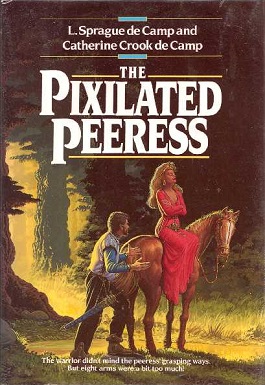
The Pixilated Peeress is a fantasy novel by American writers L. Sprague de Camp and Catherine Crook de Camp. It is the second book in their sequence of two Neo-Napolitanian novels, following The Incorporated Knight. It was first published in hardcover by Del Rey Books in August 1991, and in paperback by the same publisher in September 1992. An E-book edition was published by Gollancz's SF Gateway imprint on September 29, 2011 as part of a general release of de Camp's works in electronic form.
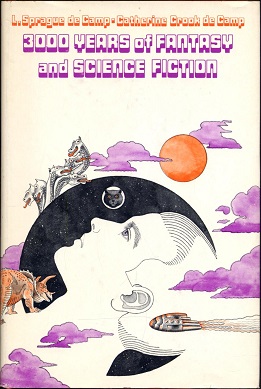
3000 Years of Fantasy and Science Fiction is an anthology of fantasy and science fiction short stories, edited by American writers L. Sprague de Camp and Catherine Crook de Camp. It was first published in both hardcover and paperback by Lothrop Lee & Shepard in 1972. It was the first such anthology assembled by the de Camps, preceding their later Tales Beyond Time (1973).
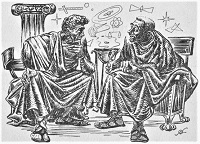
"Aristotle and the Gun" is a time travel and alternate history science fiction story by American writer L. Sprague de Camp.

"The Gnarly Man" is a science fiction story by American writer L. Sprague de Camp, about an apparently immortal Neanderthal Man surviving into the present day.

Two Complete Science-Adventure Books was an American pulp science fiction magazine, published by Fiction House, which lasted for eleven issues between 1950 and 1954 as a companion to Planet Stories. Each issue carried two novels or long novellas. It was initially intended to carry only reprints, but soon began to publish original stories. Contributors included Isaac Asimov, Robert A. Heinlein, Arthur C. Clarke, Poul Anderson, John Brunner, and James Blish. The magazine folded in 1954, almost at the end of the pulp era.
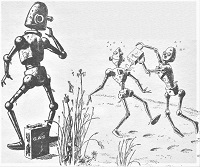
"Internal Combustion" is a classic science fiction robot story by L. Sprague de Camp. It was first published in the magazine Infinity Science Fiction for February, 1956. It first appeared in book form in the collection A Gun for Dinosaur and Other Imaginative Tales ; it later appeared in the anthologies Souls in Metal and Top Science Fiction: The Authors' Choice. The story has been translated into German.

















